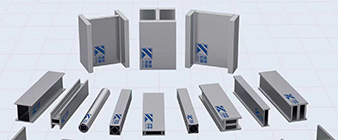High temperature resistance:
– 310S stainless steel is designed to withstand high temperature environments, with maximum operating temperatures up to 1150°C (2102°F).
– The alloy’s high chromium content (24-26%) and nickel additions (19-22%) provide excellent resistance to oxidation and scaling at high temperatures.
– This makes 310S stainless steel hollow structural profiles ideal for applications exposed to high temperatures, such as furnace components, heat exchangers and industrial process equipment.
Corrosion Resistance:
– 310S stainless steel has excellent resistance to a variety of corrosive environments, including oxidizing acids, sulfur-containing compounds, and high-temperature chlorides.
– The alloy’s high chromium and nickel content and the addition of small amounts of molybdenum give it excellent corrosion resistance.
– This corrosion resistance makes 310S stainless steel hollow structural profiles suitable for a variety of industrial applications, such as the chemical processing, petrochemical and power generation industries that are frequently exposed to harsh environments.
Mechanical Properties:
– 310S stainless steel has good mechanical strength, with typical tensile strength of 515 to 725 MPa and yield strength of 205 to 515 MPa.
– The alloy also has good ductility and toughness, maintaining good ductility and toughness even at high temperatures.
– These mechanical properties make 310S stainless steel hollow structural profiles suitable for applications requiring high-temperature structural integrity and load-bearing capacity, such as industrial equipment and process piping.
Solderability and Fabrication:
– 310S stainless steel can be easily welded using a variety of techniques, including TIG, MIG, and Stick Arc Welding (SMAW).
– The material has good ductility and formability, allowing easy fabrication of hollow structural profiles including bending, rolling and machining to produce various shapes and sizes.
– This manufacturing flexibility enables the design and construction of complex high-temperature structures and equipment using 310S stainless steel hollow sections.
Thermal expansion and thermal conductivity:
– Compared with other stainless steel grades, 310S stainless steel has a relatively high coefficient of thermal expansion, which should be considered in the design of high temperature applications.
– The alloy also has moderate thermal conductivity, which may be a factor in the design of heat transfer systems or components.
310S stainless steel has excellent oxidation resistance, corrosion resistance and good mechanical properties, making it an excellent choice for high-temperature hollow structural profiles. These properties make 310S stainless steel hollow structural profiles ideally suited for a variety of industrial applications, particularly in environments involving high temperatures and corrosive conditions, such as the chemical, petrochemical and power generation industries.
If you have specific projects or further inquiries, please feel free to ask Peak Kong Special Steel Co., Limited.!
-
 2024-9-19 904L stainless steel hollow profile
2024-9-19 904L stainless steel hollow profile -
 2024-9-19 1.4539 stainless steel hollow structural profile
2024-9-19 1.4539 stainless steel hollow structural profile -
 2024-9-25 SMO254 Super Stainless Steel for Structural Applications
2024-9-25 SMO254 Super Stainless Steel for Structural Applications -
 2024-9-19 1.4539 stainless steel structural H profile
2024-9-19 1.4539 stainless steel structural H profile -
 2024-9-24 1.4404 stainless steel Square tube, flat tube, pipe
2024-9-24 1.4404 stainless steel Square tube, flat tube, pipe -
 2024-9-16 2507 super duplex stainless steel Hollow Structural Sections
2024-9-16 2507 super duplex stainless steel Hollow Structural Sections -
 2024-9-16 Introduction to the advantages of EN standard 1.4401 stainless steel
2024-9-16 Introduction to the advantages of EN standard 1.4401 stainless steel



